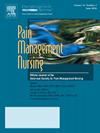Opioid Wastes Among Patients with Cancer: A Retrospective Electronic Health Record Review
IF 1.6
4区 医学
Q2 NURSING
引用次数: 0
Abstract
Problem: Opiophobia, or fear of opioids, is associated with undermanaged pain in patients with cancer. However, to our knowledge, research of documented reasons for opioid underutilization in patients with cancer is lacking. Learning the reasons patients refuse opioids as prescribed during hospital encounters may be key in mitigating opiophobia-driven poor adherence to prescribed opioids.
Purpose: To identify reasons for opioid wastes recorded by nurses in the electronic health record for one year at all locations of a comprehensive cancer center.
Methods: This descriptive study was a retrospective review of opioid wastes during 2023. Using directed content analysis, deidentified opioid wastes were categorized as intentional, accidental, or patient-related. Intentional wastes resulted from orders, policies, patient death, or pulls for wrong drug, patient, or time. Accidental wastes were unintentional (e.g., dropped on floor). Patient-related wastes were due to patient refusal or condition (e.g., nausea). Patient-related wastes were further categorized using predetermined reasons.
Results: Of 1,914 opioid wastes, most (n=1,069, 56%) were intentional and 224 (12%) accidental. 618 (32%) were patient-related; 77% (n=477) were patient refusals with 141 (23%) due to patient condition. Most patient refusals (n=477) were for no given reason (57%, n=272); requests for a different form of opioid, such as oral vs. intravenous (13.2%, n=63); or requests for a different opioid, such as tramadol vs. morphine (5.7%, n=27). Other refusals were requests for non-opioid analgesics (1.5%, n=7) or other medication (3.4%, n=16); reports of prior adverse effects (4.6%, n=22); requests for unscheduled opioid (0.4%, n=2) or another administration time (3.6%, n=17); considered opioid too strong (2.5%, n=12) or too weak (2%, n=10); family influenced (3.4%, n=16); or spat out (2.7%, n=13).
Implications: Most opioid wastes in 2023 were intentional. This finding was expected, as nurses must perform protocolized wastes (e.g., unused patient-controlled analgesia pumps) in health care settings. Few were due to accidents (e.g., loss of venous access, dropping, defective package). Most patient-related wastes were refusals for no given reason whose last known pain scores ranged from 0 to 10 with an average score of 4.5 and median score of 5.
Possibly, some refusals are influenced by opioid-related fears, including fear of side effects. Opiophobia may be amenable to intervention, which could improve pain outcomes.
求助全文
约1分钟内获得全文
求助全文
来源期刊

Pain Management Nursing
医学-护理
CiteScore
3.00
自引率
5.90%
发文量
187
审稿时长
>12 weeks
期刊介绍:
This peer-reviewed journal offers a unique focus on the realm of pain management as it applies to nursing. Original and review articles from experts in the field offer key insights in the areas of clinical practice, advocacy, education, administration, and research. Additional features include practice guidelines and pharmacology updates.
 求助内容:
求助内容: 应助结果提醒方式:
应助结果提醒方式:


